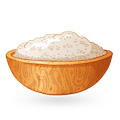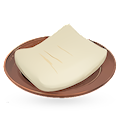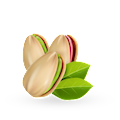MAIN INGREDIENTS
Kunāfah consists of two crunchy layers of shredded and buttered kataifi or knefe dough, filled with a luscious cheese cream that's often flavored with orange zest and cardamom, then drenched in a sugar syrup infused with lemon juice and orange blossom water.
Turkish künefe is traditionally made with Hatay, Urfa, or Antep cheese. It is usually topped with pistachios and is best served warm. Elegant and amazingly simple to make, this dessert is nothing short of what cheese-filled pastry dreams are made of.
Sfenj are popular Moroccan and Algerian doughnut-like fritters made from sticky unleavened batter, similar to Libyan sfinz and Tunisian bambalouni. The dough is traditionally shaped into rings and deep-fried until it develops a golden, crispy exterior.
The interior should be fluffy, tender, and chewy. These fritters are usually served hot when sold by street vendors, and they can be consumed plain or dusted with icing sugar.
MAIN INGREDIENTS
Fetir meshaltet is an Egyptian delicacy consisting of flaky layered pastry which can be plain or filled with various sweet or savory ingredients such as ground beef, cheese, halwa, chocolate, or raisins. The dish dates back to the time of the pharaohs, when it was often used in temples as an offering to Gods.
Nowadays, it is traditionally prepared and consumed for religious holidays, weddings, and similar social events, but the pastry is especially important as a symbol of hospitality. Plain fetir meshaltet is served with sweet and savory sides such as fruit jams, honey, cheese, and green olives, the savory filled version is served with sliced tomatoes, cucumbers, and a cup of tea, while the sweet-filled version is commonly served on its own or with fruit jams and cream.
MAIN INGREDIENTS
Every important celebration in Algeria is never complete without mkhabez, a traditional and delicate Algerian pastry. It is made with nuts (mostly almonds), sugar, eggs, and flavorings, then cut into small, elegant shapes. Essentially, it is easy to make, however; when the pastry is baked, it is meticulously decorated with royal icing.
Usually, ground almonds are used to make the base of the cake, but pistachios and walnuts are also frequently used. The most common flavoring is lemon or lemon zest, but other typical extracts such as rose water or vanilla can also be added. Traditionally, mkhabez has a triangular shape and uses only blue, pink, or white royal icing.
MAIN INGREDIENTS
This internationally known, decadent, and sugar-packed dessert is usually made with a mixture of flour, sugar, yeast, and salt, which is deep-fried and then bathed in syrup or honey. The origin of lokma fritters is ancient but often debated. It is presumed that they first appeared in Greece or Turkey, though some suggest Arabic origin.
The dish is considered to be one of the oldest recorded desserts in Greek history. It is said that the pastries were even given to winning Olympians as a treat and were called honey tokens. Loukoumades, or loukmades in Cyprus, can be found throughout the streets of Greece, in shops selling nothing else but this caloric dessert.
VARIATIONS OF Luqmat al qadi
MAIN INGREDIENTS
These crescent-shaped cookies are usually associated with Morocco, but they can be found throughout Algeria and Tunisia in slightly different forms and under various names. Their name translates as gazelle ankles, but they are better known as gazelle horns.
They consist of a thin pastry shell that is wrapped around a sweet cinnamon-flavored almond filling. Both filling and the pastry dough are typically enriched with orange blossom water. The cookies can be coated in crushed nuts or optionally dipped in orange blossom water and then dusted with sugar, in which case they are typically referred as kaab el ghazal m'fenned.
Koeksister is a sweet South African snack with a sticky appearance. It is prepared by frying braided dough strips in oil, then dunking them into a cold sugary syrup. These sticky treats are sold on every major street in South Africa, and today they can even be found in most supermarkets.
It is recommended to top them with cinnamon or lemon juice before consumption.
MOST ICONIC Koeksister
View moreKaak warka are traditional Tunisian pastries shaped into rings, making them visually similar to donuts. They're filled with marzipan that's flavored with rosewater. This sweet pastry is made with a combination of flour, butter, water, almonds, sugar, and rosewater.
The dough is baked in the oven at low heat so that kaak warka doesn't change its color. Once baked, the sweet pastry is cooled, and it's recommended to serve it with a cup of coffee on the side. Kaak warka is usually prepared for all types of important celebrations.
Makroudh is a famous North African dessert which usually consists of a sweet date filling that is placed inside semolina dough. It is fried or baked, and then doused in honey-based syrups which are often flavored with lemon or orange. The name derives from the word makrout, translated as diamond-shaped, which describes the traditional shape of these sweet treats.
Since they are eaten throughout North Africa, they appear in numerous variations. Many of them use figs or almonds as the filling and flavor the cakes with cinnamon, cloves, and orange water. Even though they are an everyday treat found in many North African households, they are a staple dessert on many special and festive occasions.
MAIN INGREDIENTS
Yovo doko is typical Beninese street food that is considered a national dessert. These sweet fritters consist of flour, water, yeast, and sugar. The dough is deep-fried until a golden crust develops on the exterior, while the inside remains soft and tender.
Yovo doko fritters are traditionally topped with powdered sugar and consumed any time of the day. The name of the dish is literally translated to European pastry, because yovo doko is very similar to the French beignet, a popular type of fritter made from deep-fried choux pastry.
TasteAtlas food rankings are based on the ratings of the TasteAtlas audience, with a series of mechanisms that recognize real users and that ignore bot, nationalist or local patriotic ratings, and give additional value to the ratings of users that the system recognizes as knowledgeable. For the “Top 17 African Sweet Pastries” list until March 21, 2025, 2,586 ratings were recorded, of which 902 were recognized by the system as legitimate. TasteAtlas Rankings should not be seen as the final global conclusion about food. Their purpose is to promote excellent local foods, instill pride in traditional dishes, and arouse curiosity about dishes you haven’t tried.





















